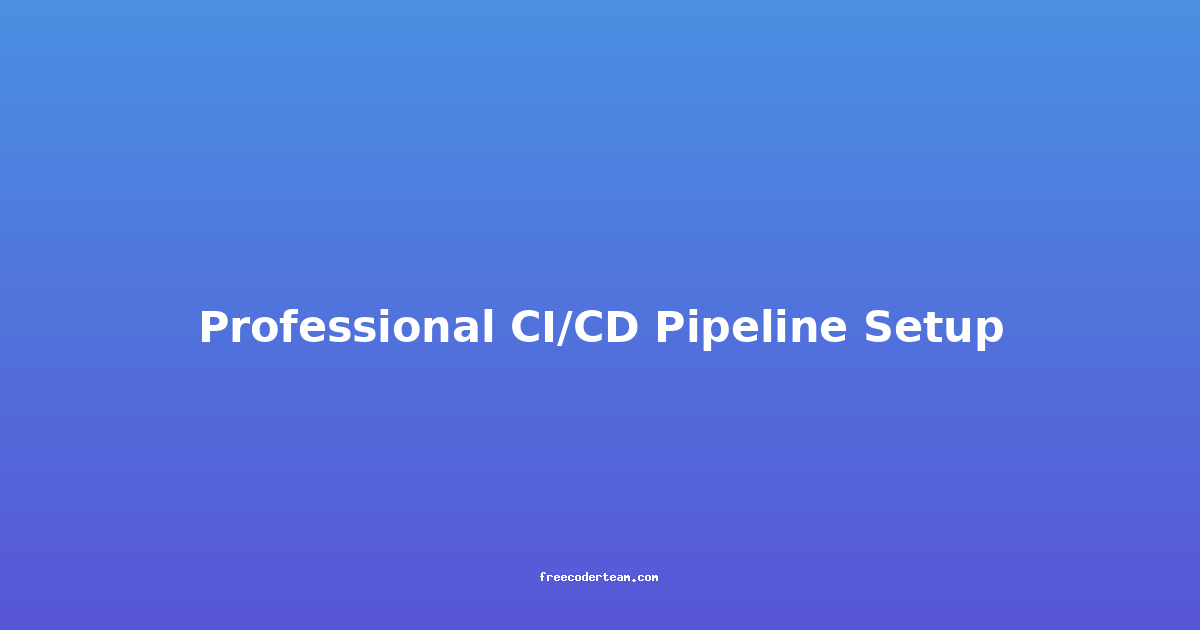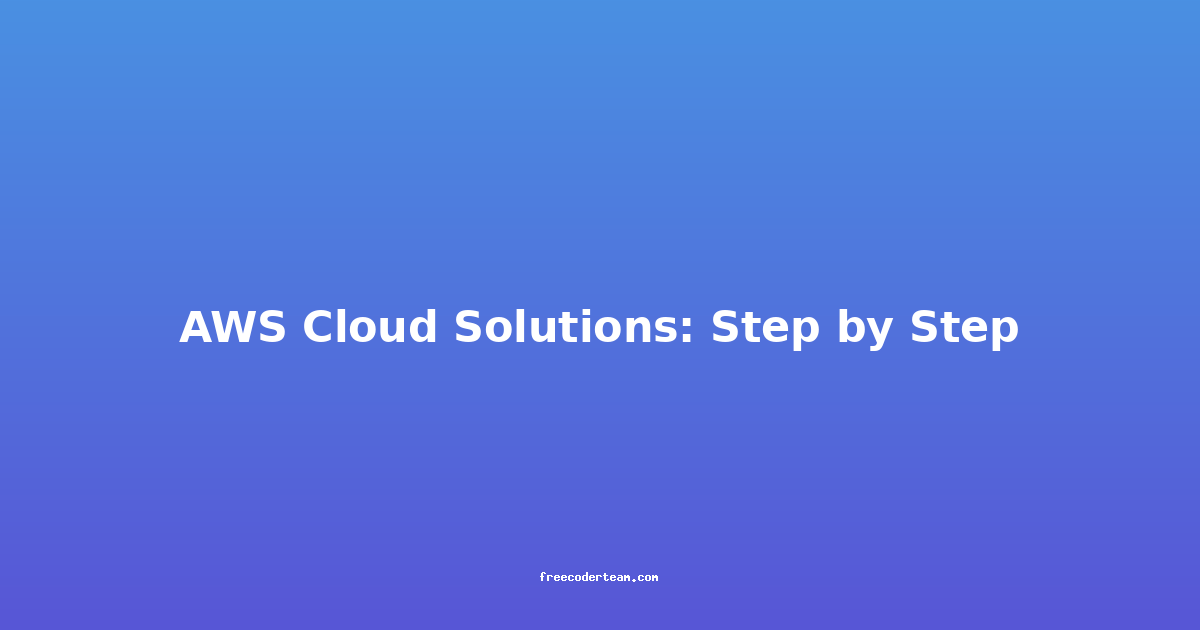Professional CI/CD Pipeline Setup: Best Practices and Practical Insights
Continuous Integration/Continuous Deployment (CI/CD) pipelines are the backbone of modern software development, enabling teams to deliver high-quality software faster and more reliably. A well-designed CI/CD pipeline automates the testing, building, and deployment processes, reducing manual errors and ensuring consistent releases. This blog post will guide you through setting up a professional CI/CD pipeline, covering best practices, practical examples, and actionable insights.
Table of Contents
- Introduction to CI/CD
- Key Components of a CI/CD Pipeline
- Best Practices for CI/CD Pipeline Setup
- Practical Example: Setting Up a CI/CD Pipeline with GitHub Actions
- Actionable Insights and Common Pitfalls
- Conclusion
Introduction to CI/CD
CI/CD is a methodology that automates the software release process, ensuring that code changes are integrated, tested, and deployed quickly and safely. Here's a brief overview of the two components:
- Continuous Integration (CI): Developers frequently merge their code changes into a central repository, and automated builds and tests are run to catch integration issues early.
- Continuous Deployment (CD): Once the code passes CI tests, it is automatically deployed to the production environment, ensuring rapid and reliable releases.
CI/CD helps teams achieve faster feedback cycles, reduce manual errors, and improve overall software quality.
Key Components of a CI/CD Pipeline
A professional CI/CD pipeline consists of several key stages, each serving a specific purpose. Understanding these components is essential for building an effective pipeline.
1. Source Code Management
- Tool: GitHub, GitLab, Bitbucket
- Purpose: Version control for your codebase.
- Example: Developers push code changes to a Git repository.
2. Build
- Purpose: Compile and package the code into a deployable format.
- Tools: Docker, Maven, Gradle, npm
- Example: Build a Node.js application using
npm installandnpm run build.
3. Testing
- Types: Unit tests, integration tests, end-to-end tests, security tests, performance tests.
- Tools: Jest, Mocha, Cypress, SonarQube
- Purpose: Ensure the code meets quality standards.
- Example: Run unit tests using Jest:
// example.test.js import { add } from './index.js'; test('adds 1 + 2 to equal 3', () => { expect(add(1, 2)).toBe(3); });
4. Code Quality Checks
- Purpose: Enforce coding standards and detect potential issues.
- Tools: ESLint, Prettier, SonarQube
- Example: Use ESLint for JavaScript code quality:
eslint src/**/*.js
5. Artifact Storage
- Purpose: Store build artifacts (e.g., Docker images, JAR files) for later use.
- Tools: Docker Hub, Nexus, Artifactory
- Example: Push a Docker image to Docker Hub:
docker build -t my-app:latest . docker push my-app:latest
6. Deployment
- Purpose: Automatically deploy the application to staging or production environments.
- Tools: Kubernetes, AWS ECS, Heroku, Terraform
- Example: Deploy a Dockerized application to Kubernetes:
# deployment.yaml apiVersion: apps/v1 kind: Deployment metadata: name: my-app spec: replicas: 3 selector: matchLabels: app: my-app template: metadata: labels: app: my-app spec: containers: - name: my-app image: my-app:latest ports: - containerPort: 3000
7. Monitoring and Logging
- Purpose: Track the health of the application and gather logs for debugging.
- Tools: Prometheus, Grafana, ELK Stack (Elasticsearch, Logstash, Kibana)
- Example: Monitor application performance using Prometheus:
prometheus --config.file=prometheus.yml
Best Practices for CI/CD Pipeline Setup
To ensure your CI/CD pipeline is robust and efficient, follow these best practices:
1. Keep the Pipeline Simple and Modular
- Why: A simple pipeline is easier to maintain and debug.
- How: Break the pipeline into smaller, reusable steps (e.g., build, test, deploy).
2. Automate Everything
- Why: Automation reduces human error and speeds up the release process.
- How: Use tools like GitHub Actions, Jenkins, or GitLab CI/CD to automate every step.
3. Parallelize Tasks
- Why: Parallel execution can significantly reduce pipeline runtime.
- How: Run tests in parallel or distribute build tasks across multiple machines.
4. Version Control Everything
- Why: Ensure consistency and traceability.
- How: Use version control for infrastructure (e.g., Terraform) and configuration files.
5. Use Environment Variables
- Why: Keep sensitive information secure and avoid hardcoding credentials.
- How: Use tools like Vault or environment variables in your CI/CD platform.
6. Implement Rollback Strategies
- Why: Ensure you can quickly revert to a stable version if something goes wrong.
- How: Use versioned deployments or Canary releases.
7. Monitor Pipeline Health
- Why: Detect issues early and improve pipeline stability.
- How: Use tools like Prometheus to monitor pipeline performance.
Practical Example: Setting Up a CI/CD Pipeline with GitHub Actions
GitHub Actions is a popular CI/CD platform that allows you to automate your workflows directly on GitHub. Below is an example of setting up a pipeline for a Node.js application.
1. Repository Setup
- Create a GitHub repository and push your code.
- Ensure your project has a
package.jsonfile and a test suite (e.g., using Jest).
2. Create the .github/workflows Directory
In your repository, create a .github/workflows directory and add a main.yml file.
3. Write the Workflow YAML
Here's an example of a CI/CD pipeline for a Node.js application:
# .github/workflows/main.yml
name: Node.js CI
on:
push:
branches: [main]
pull_request:
branches: [main]
jobs:
build:
runs-on: ubuntu-latest
steps:
- uses: actions/checkout@v3
# Checkout the repository to the runner
- name: Use Node.js
uses: actions/setup-node@v3
with:
node-version: '16'
cache: 'npm'
- run: npm install
# Install dependencies
- run: npm test
# Run tests
env:
CI: true
- name: Build the application
run: npm run build
- name: Package the application
run: npm pack
- name: Push to Docker Hub
uses: docker/build-push-action@v2
with:
context: .
file: ./Dockerfile
push: true
tags: my-app:latest
- name: Deploy to Kubernetes
run: |
kubectl apply -f deployment.yaml
kubectl rollout status deployment/my-app
env:
KUBECONFIG: ${{ secrets.KUBECONFIG }}
4. Explanation of the Workflow
- Checkout: Clones the repository to the runner.
- Node.js Setup: Sets up the Node.js environment and caches
node_modules. - Install Dependencies: Installs npm packages using
npm install. - Run Tests: Executes the test suite using
npm test. - Build Application: Builds the application using
npm run build. - Package Application: Creates a package using
npm pack. - Docker Build and Push: Builds a Docker image and pushes it to Docker Hub.
- Kubernetes Deployment: Deploys the application to a Kubernetes cluster.
5. Environment Variables
- Secrets: Store sensitive information (e.g., Docker Hub credentials, Kubernetes config) as GitHub Secrets.
- Example: Store the Docker Hub token as a secret named
DOCKER_HUB_TOKENand reference it in the workflow:- name: Docker Meta run: echo "{\"auths\": {\"https://index.docker.io/v1/\": {\"username\": \"${{ secrets.DOCKER_HUB_USERNAME }}\", \"password\": \"${{ secrets.DOCKER_HUB_TOKEN }}\"}}}" > /github/home/.docker/config.json
Actionable Insights and Common Pitfalls
1. Start Small, Scale Up
- Begin with basic tests and deployments, then gradually add more stages as needed.
2. Use Feature Flags
- Implement feature flags to roll out new features gradually without affecting all users.
3. Regularly Review and Optimize
- Periodically review your pipeline to identify bottlenecks and areas for improvement.
4. Handle Failures Gracefully
- Implement retry mechanisms and error handling for flaky tests or unstable services.
5. Common Pitfalls to Avoid
- Overcomplicating the Pipeline: Keep it simple and modular.
- Ignoring Security: Use secure practices, such as encrypting secrets.
- Not Monitoring: Lack of monitoring can lead to undetected issues.
Conclusion
Setting up a professional CI/CD pipeline is essential for modern software development. By automating the build, test, and deployment processes, teams can deliver high-quality software faster and more reliably. This blog post covered the key components of a CI/CD pipeline, best practices, and a practical example using GitHub Actions.
Remember, the goal of a CI/CD pipeline is to streamline the development process, reduce errors, and improve collaboration. Start small, iterate, and continuously optimize to ensure your pipeline meets your team's needs.
Happy coding! 🚀
If you have any questions or need further assistance, feel free to reach out!




